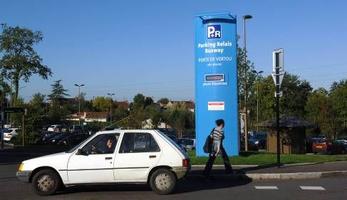Introducing park and ride facilities and parking standards
Summary
As part of its efforts to achieve a modal shift in favour of public transport and a better use of public space, Nantes introduced a parking policy and city-centre access restrictions.
Implementing sustainable mobility
In response to high volumes of traffic in the centre of Nantes, the measure was designed to improve mobility management in order to achieve a balance between the various modes of transport, ensure user-friendly and safe spaces for pedestrians, give priority to public transport vehicles and reduce congestion and pollution. The city also needed to tackle the problem of illegal parking: cars regularly blocked pavements obliging pedestrians to step into the road; and commuters occupied parking spaces needed by service vehicles or residents in the city centre.
A parking policy is an effective tool by which local transport authorities can regulate urban mobility. The objectives were to:
- create car-free public spaces;
- enhance access to the city centre for visitors and discourage commuters from using cars; and
- allow city-centre residents to park their cars more easily near their homes, thus increasing their use of alternative modes of transportation within the city.
Access management was designed to promote the use of park and ride facilities among commuters by:
- extending the time-limited on-street paid parking zone in the city centre;
- reinforcing controls against illegal parking;
- introducing new on-street parking fees favouring residents and visitors; and
- developing park and ride facilities along tramlines to encourage commuters to use public transport, thus reducing the number of cars and demand for parking in the city centre.
Parking standards were also introduced for new buildings that are well connected to the public transport network in order to reduce the number of private parking spaces.
Progress
In 2003, the Nantes–Vertou railway link opened with park and ride facilities at the Vertou, Frene Rond and Pas Enchantes stations offering a total of 372 parking spaces. The Vertou park and ride was then extended with 100 new parking spaces.
In 2004, a new park and ride facility opened in Orvault-Morliere in connection with the extension of tram number 3. In 2005, several more facilities were opened: 460 parking spaces in the southeast area of the city (along the new priority bus route); 170 parking spaces in the southwest area of the city (tram 2); and 155 parking spaces for people using the Nantes–Trentemoult river shuttle. This meant a total of 5,803 parking spaces in 39 park and ride facilities in 2011.
Nantes produced a guide to the improved parking facilities in the suburban and central areas of the city, which was widely distributed.
Outcomes
The measure improved the flow of traffic in the city, allowing visitors (service and delivery vehicles) to find a parking space more quickly without having to drive around looking for one. It also enhanced the quality of the city’s public spaces by eliminating illegal parking.
With the reduction of long-stay parking demand and the resulting removal of on-street parking spaces, pedestrian areas could be enlarged and cycle lanes and bus corridors developed.
The rate of occupancy of the park and ride facilities shows a rapid progression. Some of the facilities were overcrowded in their first week of operation and required immediate extension. However, traffic levels in the city remain high because of the big supply of private car parks provided by the main employers in the city centre. This can be tackled by increasing their awareness through company mobility plans.







